Hello all, I've been taking a break from traveling for a while because I've been strangely lazy. I decided to visit this museum almost a week ago but I visited it yesterday and I have to admit that it is the best museum I have ever visited. The fact that I've never visited an archaeology museum before might have something to do with it, but it was really great. When I visited other museums, I definitely enjoyed it, but when I left this museum, my soul was really refreshed and I learned a lot of historical information. I saw things I had never seen before in my life and the atmosphere was incredible. Without further ado, let's move on to the photos I took inside the museum.

If you have read my previous museum articles, I always take a photo of the building first and that's usually the cover photo, but the inside of this museum is much more beautiful than the outside and I will put my favorite photos on the cover. I designed something in Canva for the first time, I hope it turned out well. It looked good to me, but in the end, the important thing is whether you like it or not. Don't forget to leave your comments about the cover photo.


You need to buy a ticket to enter the museum and this ticket is 25 TL, that is 1,5 dollars. After buying your ticket, you can watch a video with historical information about Adana and Cilicia on a projector like this. I think the image is a bit poor quality and not clear because of the screen. It was not clear on my camera either.

Afterwards it was like a dream for me, look at this sarcophagus, the details of the engravings on it are really incredible. Many of today's artists are not that good. Every corner has a different detail and this was one of the parts that impressed me the most. On the right you can see the tombstones. I took many of them close up and I will share them with you.


These tombstones belong to the 2-3rd century as you can read from the inscription below. There are inscriptions under the reliefs and I think this is their names. Seeing two people together made me think that they were buried together, but I am not sure about that. The tombstones are made of basalt, you can read this from the inscription underneath.


There are 2 tombstones with eagle reliefs and one with 3 people holding their hands as if saying "okay". I'm sure they didn't make that sign but it looks very similar. I don't think they buried animals in the eagle ones either, maybe it was a tombstone of a soldier with a rank or maybe the person asked for such a relief to be made before he/she died. Unlike the first two, the tombstones here are made of limestone.

Other tombstones from the same period. It really amazes me how detailed they are. Especially the one on the bottom right. Michelangelo of that period must have done these.


What about the details on these sarcophagi? Look at the details of the skirts, these are really masterpieces. They didn't leave anything out, right down to the toes and fingernails.

Both sarcophagi are from the 3rd century Roman period. I'm not going to put separate informative articles for both of them because this post will be too long.



Some of the other sarcophagi in the museum. It was very difficult to choose which one to share as they all have incredible details. These are the most beautiful ones for me.



Other tombstones from the 2-3rd century, like the majority, made of limestone.


I've seen in documentaries that statues of gods were often made at that time. Here is a statue of the moon god. It looks magnificent. Although there is no information about it, there seems to be a crescent moon under the face. It's a Roman artifact from the 2nd century AD.

Look at this cool guy hahaha. He looks quite interesting with his gold. I didn't see any inscription about it, but since all the artifacts in this section are from the Roman period, I think this one is too.


Here is one of the things I learned in the museum, the ostoteks. There is an information article about it but as you can see it is not very clear but let me briefly summarize what I read from that article. Ostoteks are a kind of child sarcophagus. In ancient Rome, special sarcophagi were made for children according to the wishes and assets of the families.

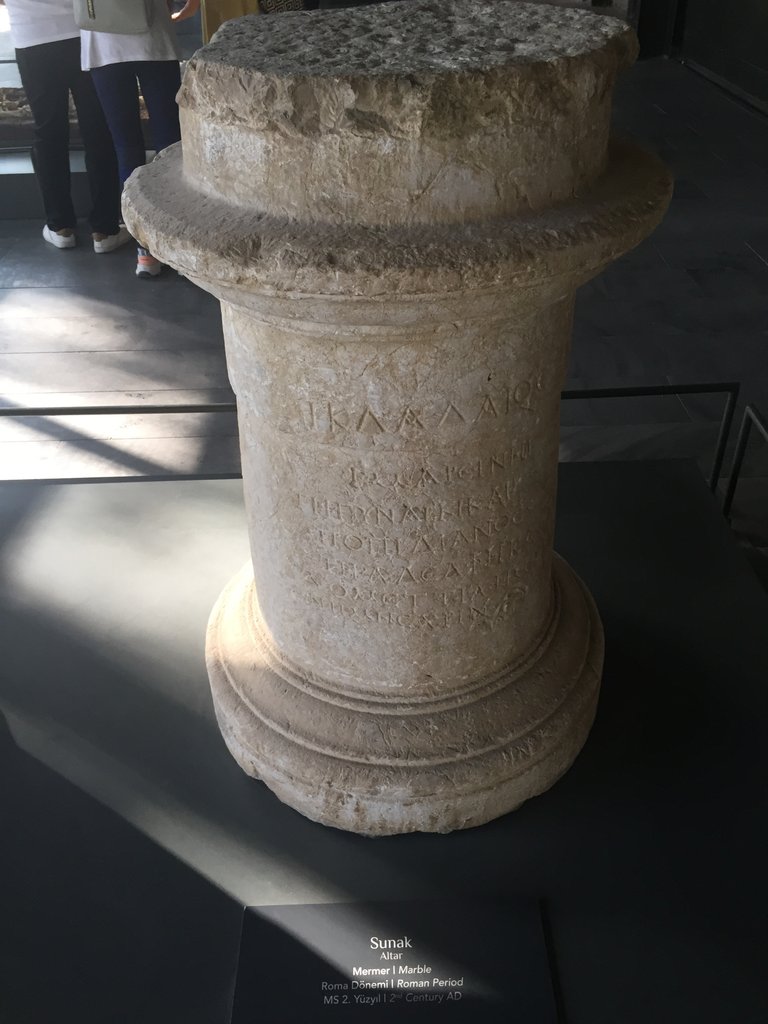

These are tombstones and altars made of stone. I have seen many tombstones from the same period made of different materials and I think the reason for this difference is money. So your wealth could change everything in those times too lol.


Marble columns from the same period. It is impossible to say that the construction industry now is better than it was then. You can tell the quality of the materials they use to build just by seeing it.



Behind the columns there were 3 big and wonderful statues. The first one you see is at least 2,50 meters tall and it doesn't even have a head. The details on the right leg of the statue really amaze me. I know I use this word a lot but isn't it strange that they could do something like this 1800 years ago? I hope I'm not the only one surprised by this.


Just behind the lion statue there were other small statues like this and they probably belong to the same Roman period. In the second photo you can see which one is my favorite.
After the section with the statues, I went into the section with mostly antiquities. There was music playing in the background that made my historical feelings swell and it really helped me feel the atmosphere. I imagined how everything I saw was used in ancient times.

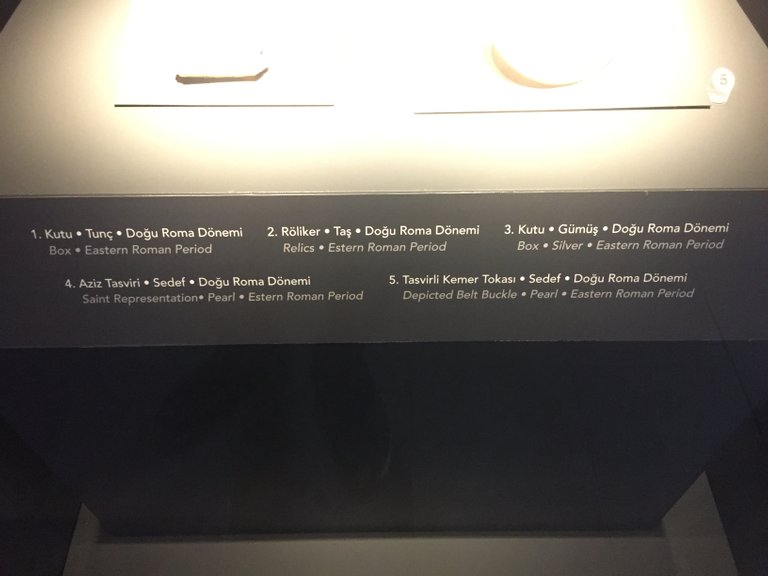
Boxes and things that were used in ancient times. From everything we've seen so far, it seems that people in ancient Rome were very fond of luxury. Even the belt buckles are quite magnificent and there is always a depiction on them.



Icons, crosses and a cross mould from the Eastern Roman period. I think people kept their own paintings in their homes in the form of icons instead of paintings. I think it's cooler than a painting hanging on the wall. I wonder how much people paid for something like that in that time?


Eastern Roman bread stamp and seal impression, I don't know why they stamped the bread, I wonder if it's healthy.


Oil lamps from the same period. They look quite useful for that time. Most of them are made of earthenware. Except the one in the center at the top. That's made of bronze.


Scales, plates, jugs and ornaments, also from the Eastern Roman period. As you can see, they are all decorated and engraved.

An inscription about the history of the Eastern Roman Empire. I have a close-up of it in English, but I won't share it here because everything is clear.

A censer from the Eastern Roman period, the inscription is very blurred so I'm not going to share it.


A box from the same period. It was made of silver and glittered from a distance. Definitely one of my favorites.
We're going back in time a little bit and we're going to take a look at the Roman artifacts from the 1st and 2nd centuries, of which you've just seen statues and tombstones. It might be a bit confusing, but I tried my best to organize it, because in the museum everything was a bit disorganized as well.

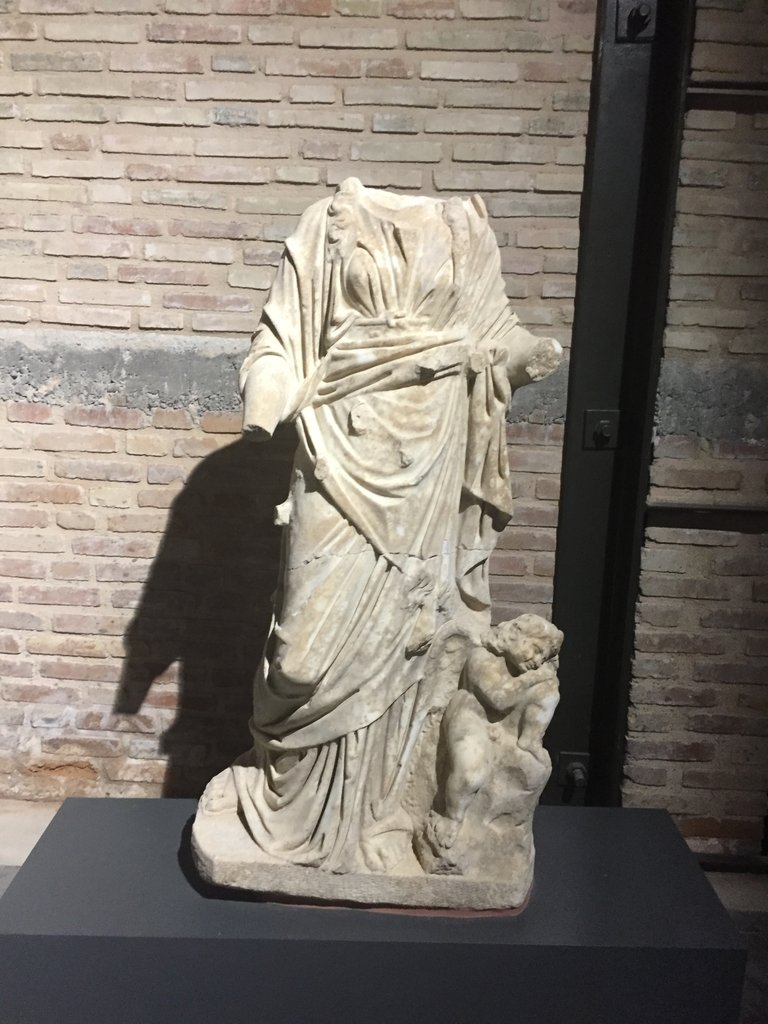
Roman sculptures from the 1-2th centuries. I'm also very curious to know how much effort it took to make such detailed sculptures. How many days do you think these sculptures were made? Or how many months?

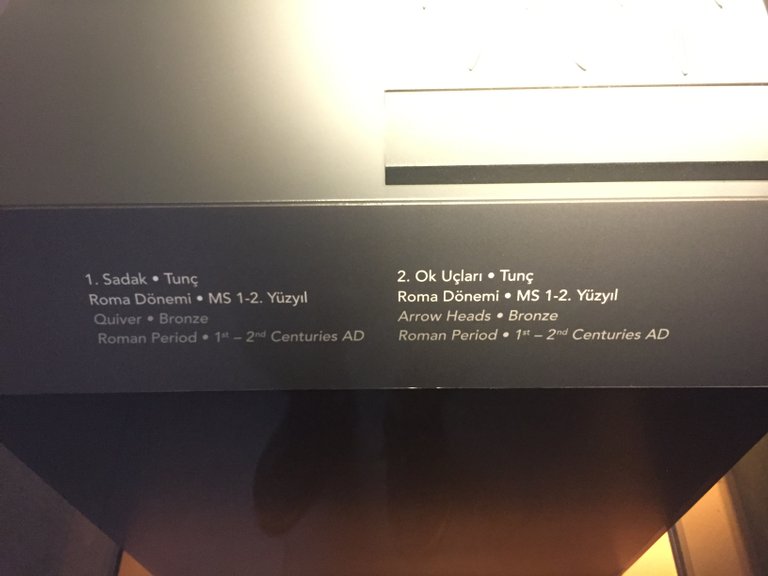
Roman quiver and arrowheads


These are Roman swords. They look a bit small to me, but I don't know how much they weigh, so I don't want to comment too much. Also, probably everyone was using short swords like this at that time.

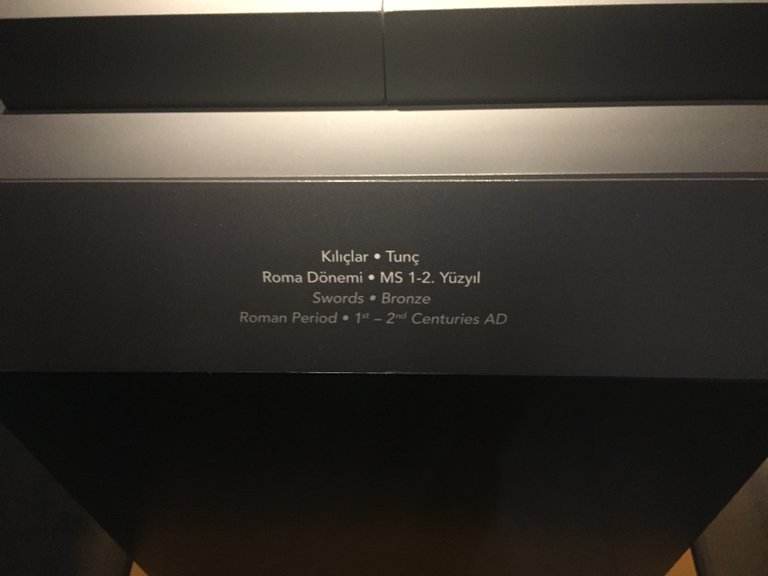
Roman swords

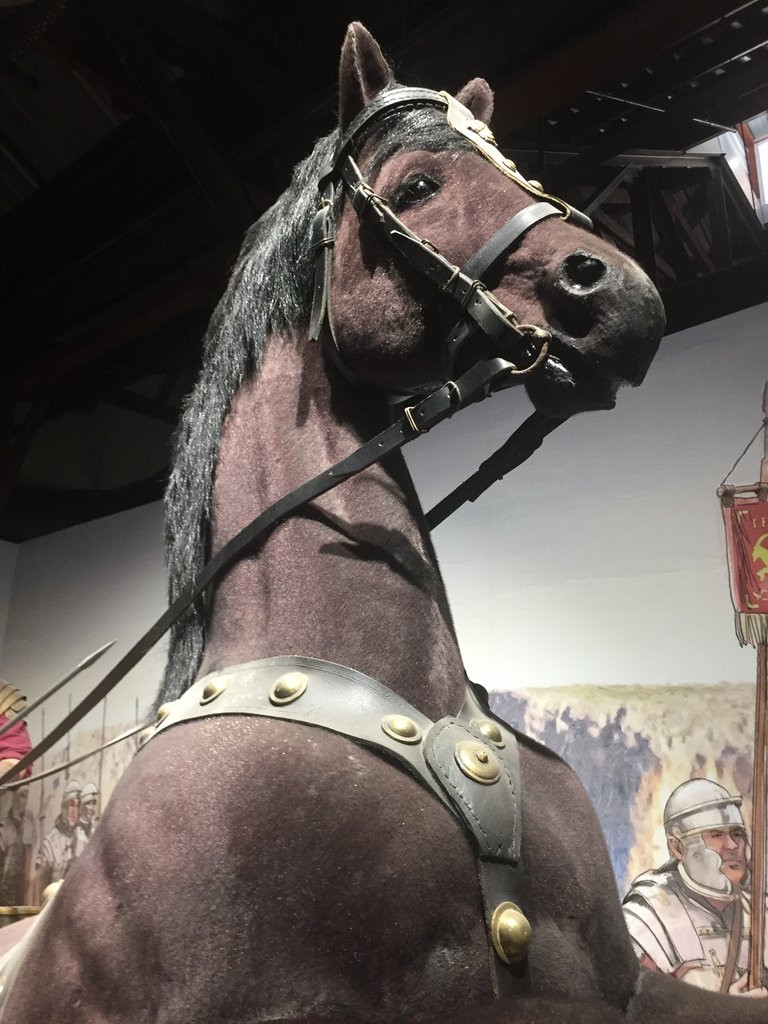
What impressed me the most in this section was this statue from the Roman period. The statue was not made during the Roman period, it is just a statue of a legionnaire from that period. It is incredibly realistic and the texture is very good. I didn't touch anything in the museum, but I touched this horse with my finger and it was like a real horse. I took a selfie in front of this statue but I won't share it because it was too bad.








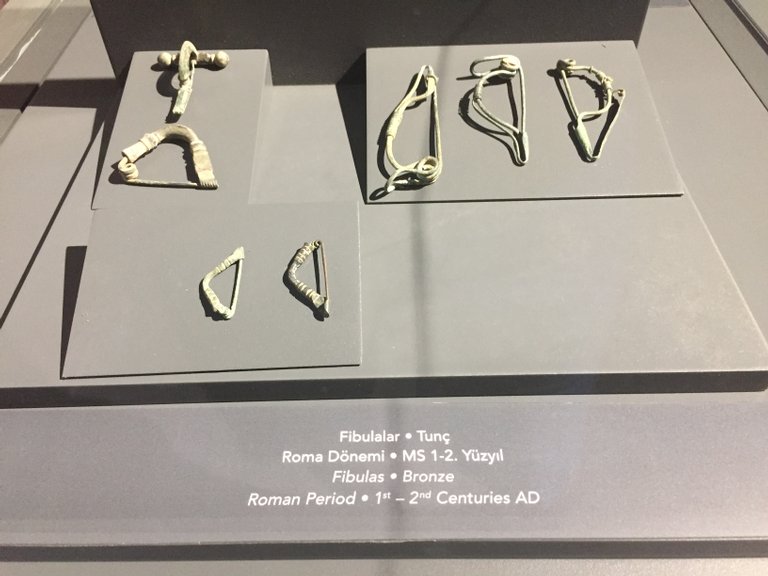
I realized that if I talk about all of this one by one, the post would not end. Some of this jewelry from ancient Rome is really dazzling. Especially the earrings caught my attention.


An inscription describing the clothing in ancient Rome.

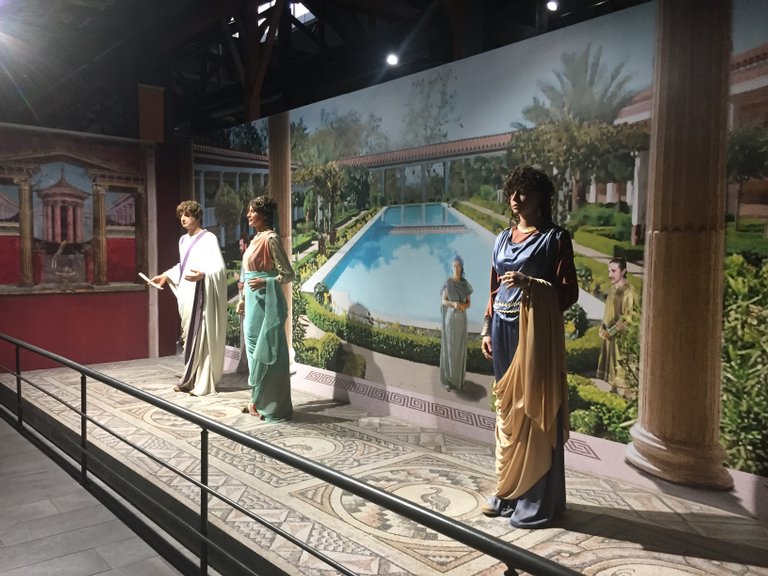
Sculptures of ancient Roman clothes probably made in modern times. It's detailed and perfectly made. I think they are much more beautiful than the clothes that are fashionable today. They look very elegant. I hope in the next 15 years fashion will evolve back to something like that.
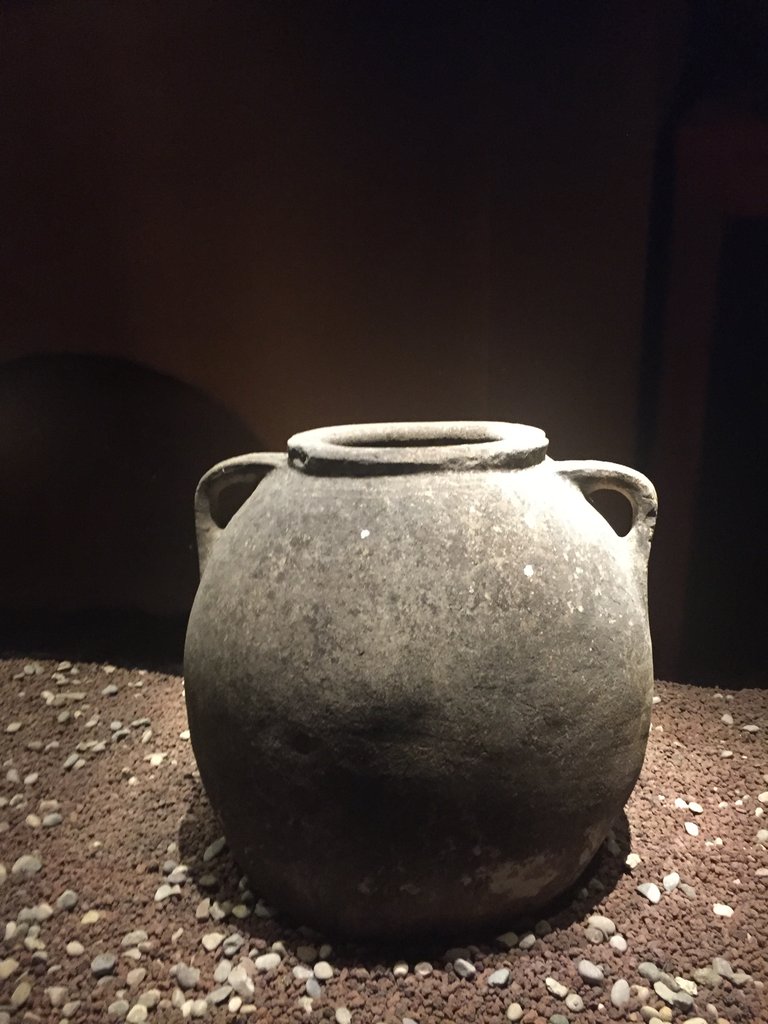
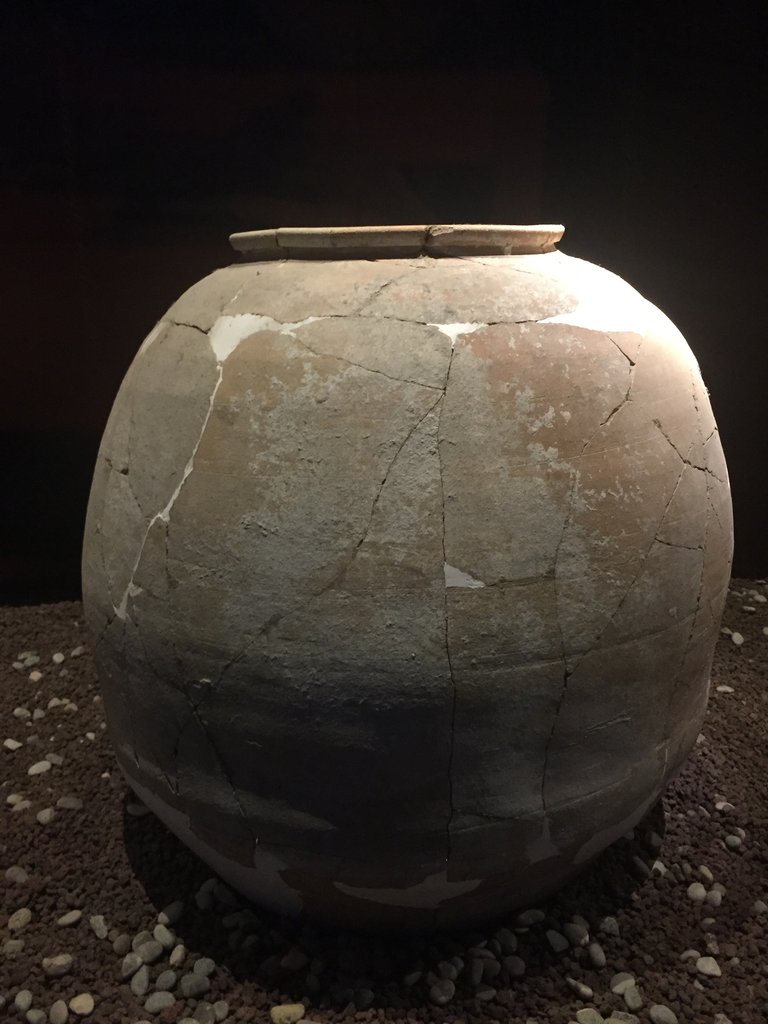

People used to store their grains and olives in big pots like this one. There was an article about it but I couldn't take a proper photo of it because it was hanging almost on the ceiling.



The previous ones were mostly used by rich people. Here are the plates and pots probably used by some poor or ordinary people.


Pictures of daily life in ancient Rome. I don't think it's exactly like this, but this is what we have.

Here is an article about the history of glass. Did you know that the oldest glass found in Anatolia was used by the Hittites in 1700 BC?
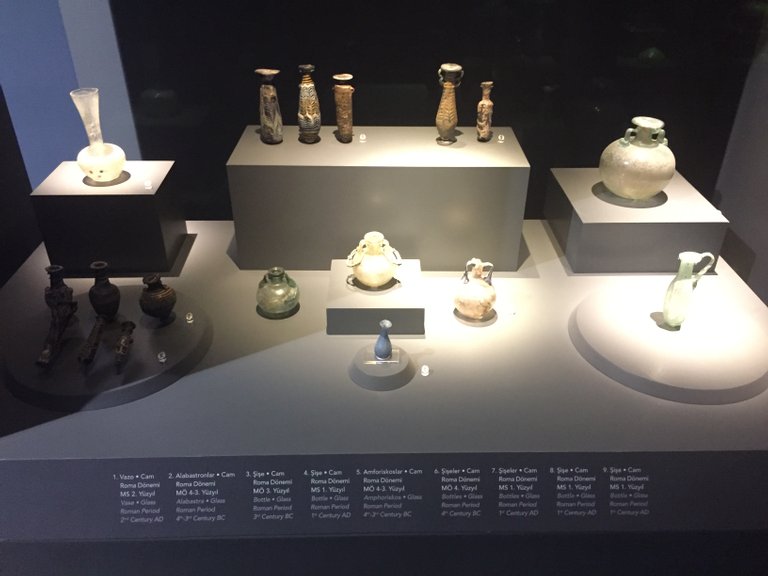





Some items made of glass in ancient times. You can see many things from plates to bottles.



A depiction and text of burial customs in Roman times. At that time people were either buried or cremated. Who made the decision? The person or their family?



Some sculptures, also from the ancient Roman period. Although the figure of Hermes is immediately striking, what really caught my attention are the details on the helmet of the standing soldier.
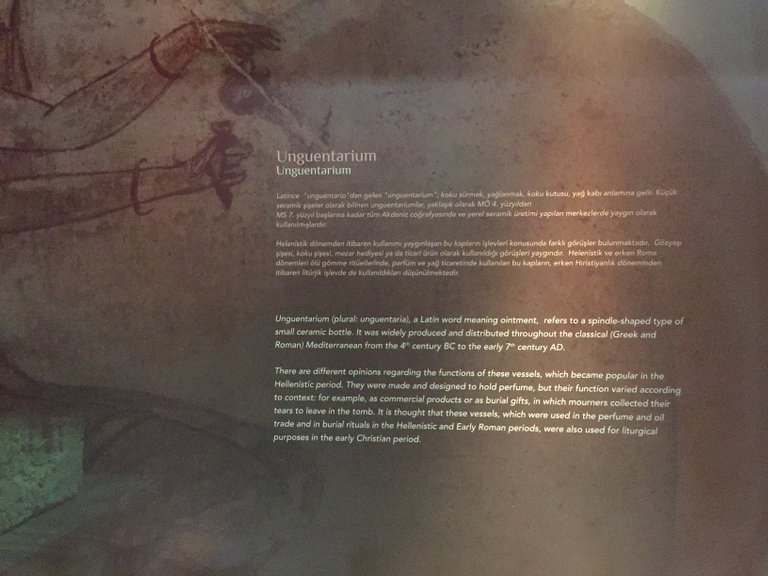


Unguentarium... This word, which I heard for the first time in my life, is the name given to the bottles in the photo. There are many opinions about what these are. Some think they were souvenirs, some think they were scent bottles, some think they were used as grave gifts. What do you think these bottles were used for?

Gold mouth, eye and forehead bands. I don't really know what they were used for, I think they were used to bury the dead. When else would you need a mouth band?



This is the most magnificent and beautiful sarcophagus I've seen in the museum. Because there are different carvings on each side. I really think it belonged to a noble person, maybe a general.



This is another sarcophagus that I like the most in the museum. The face of the person is depicted on the tomb. It is also a bit funny to comment on these tombs as my favorite. I mean it's kind of funny that 5000 years from now someone will look at your tomb and say wow this is the best tomb I've ever seen lol.
Actually there are many more things I have seen in the museum but this post has been long enough and I don't want to make it longer, maybe a few weeks from now I will share a few historical artifacts that I have seen in this museum and write my thoughts about them but for now I will not share more historical artifacts.



There is a souvenir shop in the museum and there are some really cool things in there. While I was looking at these products, a woman was buying a necklace worth about 1000 TL (50 USD).

The museum also has a cafe and they have everything you want. You can eat, drink coffee, cold drinks and whatever you want. I liked that very much. I didn't have a drink because it was almost closing time, but next time I think I will definitely have a drink there. It would be great to sit there and have a coffee while watching the historical artifacts.
This concludes my post about this wonderful archaeological museum. I realize it is quite a long post, I hope you enjoyed reading it. If anyone reads this far and I see someone who adds the word "Hivecubus" to their comment, I will upvote 100% their comment. I hope you only read the end and don't cheat 😂. Anyway, I wish you all a wonderful day!
TR
Hepinize merhaba, bir süredir bir yerler gezmeye ara vermiştim çünkü üzerimde garip bir tembellik var. Bu müzeyi gezmeye neredeyse 1 hafta önce karar verdim ama müzeyi dün gezdim. Şunu itiraf etmeliyim ki şimdiye kadar gezdiklerim arasında en iyi müze. Daha önce hiç arkeoloji müzesi gezmemiş olmam da bu görüşümde etkili olabilir ancak gerçekten harikaydı. Diğer müzeleri gezdiğimde kesinlikle keyif almıştım ancak bu müzeden çıktığımda ruhum gerçekten ferahlamıştı ve bir sürü tarihi bilgi öğrendim. Hayatımda daha önce görmediğim şeyler gördüm ve atmosfer inanılmazdı. Lafı daha fazla uzatmadan müzenin içinde çektiğim fotoğraflara geçelim.

Daha önceki müze yazılarımı okuduysanız önce her zaman binanın bir fotoğrafını çekerim ve kapak fotoğrafında genelde o olur ancak bu müzenin içindekiler dışından çok daha güzel ve favori fotoğraflarımı kapağa koyacağım. İlk defa Canva'da bir şeyler tasarladım umarım güzel olmuştur. Bana güzel gibi göründü ama sonuçta önemli olan sizin beğenip beğenmemeniz. Kapak fotoğrafına dair görüşlerinizi yoruma yazmayı unutmayın.


Müzeye girişte bir bilet almanız gerekiyor ve bu bilet 25 TL yani 1,5 dolar. Bu fiyata fazlasıyla değdiğini düşünüyorum. Biletinizi aldıktan sonra bu şekilde bir projeksiyon cihazında Adana ve Kilikya'ya ait tarihi bilgiler içeren bir videoyu izleyebilirsiniz. Sanırım perdeden kaynaklı görüntü biraz kalitesiz ve net değil. Kameramda da net çıkmadı zaten.

Sonrası benim için rüya gibiydi, şu lahite bakın, üzerindeki işlemelerin ayrıntıları gerçekten inanılmaz. Günümüzdeki sanatçıların birçoğu bu kadar başarılı değil. Her köşesinde başka bir ayrıntı var ve en çok etkilendiğim kısımlardan biri burasıydı. Sağ tarafta da mezar taşlarını görebilirsiniz. Birçoğunu yakından çektim ve sizinle paylaşacağım.


Bu mezar taşları altındaki yazıdan da okuyabileceğiniz gibi 2-3. yüzyıla ait. Kabartmaların altında yazılar var ve bu da sanırım isimleri. İki kişinin birlikte görülmesi ikisinin birlikte defnedildiğini düşündürdü ama bundan emin değilim. Mezar taşları bazalttan yapılmış, bunu da altındaki bilgilendirme yazısından okuyabilirsiniz.


Burada da 2 tane kartal kabartmalı mezar taşı ve bir tane de 3 insanın ellerini "okay" der gibi yaptığı kabartma var. O işareti yapmadıklarına eminim ancak çok benzer görünüyor. Kartal olanlara da hayvan gömdüklerini zannetmiyorum, belki rütbeli bir askerin mezar taşıdır ya da kişi ölmeden önce böyle bir kabartma yapılmasını istemiş olabilir. İlk ikisinden farklı olarak buradaki mezar taşları kireçtaşından yapılmış.

Aynı döneme ait başka mezar taşları. Bu kadar ayrıntılı olmaları gerçekten beni çok şaşırtıyor. Özellikle sağ alttakine bakın. O dönemin Michelangelo'su bunları yapmış olmalı.


Şu lahitlerdeki ayrıntılara ne diyorsunuz? Eteklerin detaylarına bakın, bunlar gerçekten birer şaheser. Ayak parmakları ve tırnaklarına kadar hiçbir şeyi atlamamışlar.

İki lahit de 3. yüzyıl Roma dönemine ait. İkisinin ayrı ayrı bilgilendirme yazılarını koymayacağım çünkü bu post çok uzun olacak.



Müzedeki diğer lahitlerden bazıları. Hepsi inanılmaz detaylara sahip olduğu için hangisini paylaşacağımı seçmek çok zor oldu. Bunlar bana göre en güzelleri.



2-3. yüzyıla ait başka mezar taşları, çoğunluk gibi kireç taşından.


O zamanlarda tanrılara ait heykellerin de sıklıkla yapıldığını belgesellerde izlemiştim. İşte ay tanrısına ait bir heykel. İhtişamlı görünüyor. Bununla ilgili bir bilgi olmasa da yüzün altında ayın hilal hali var gibi görünüyor. Milattan sonra 2. yüzyıla ait Roma döneminden kalma bir eser.

Şu cool adama bakın hahaha. Altınlarıyla oldukça ilgi çekici görünüyor. Bununla ilgili bir yazıt görmedim ancak bu bölümdeki bütün eserler roma dönemine ait olduğu için bunun da öyle olduğunu düşünüyorum.


İşte müzede öğrendiğim şeylerden biri, ostotekler. Bununla ilgili bir bilgilendirme yazısı var ancak gördüğünüz gibi çok net çıkmamış ancak ben size o yazıdan okuduğum şeyleri kısaca özetleyeyim. Ostotekler bir nevi çocuk lahti. Eski Roma'da ailelerin istekleri ve mal varlıkları doğrultusunda çocuklara özel lahitler yapılıyormuş.



Bunlar da taştan yapılmış mezar taşı ve sunaklar. Aynı döneme ait farklı malzemelerden yapılmış bir sürü mezar taşı gördüm ve sanırım bu farklılığın sebebi maddiyat. Yani o zamanlarda da varlığınız her şeyi değiştirebiliyor lol.


Aynı döneme ait mermer sütunlar. Şu anki inşaat sektörünün o zamankinden daha iyi olduğunu söylemek imkansız. İnşa için kullandıkları malzemenin kalitesini sadece görerek anlayabilirsiniz.



Sütunların arkasında 3 tane büyük ve harika heykel vardı. İlk gördüğünüz heykelin uzunluğu en az 2,50 metre ve heykelin başı bile yok. Heykelin sağ bacağındaki detaylar gerçekten beni çok şaşırtıyor. Biliyorum bu kelimeyi çok kullandım ama bundan 1800 yıl önce böyle bir şeyi yapabilmeleri çok garip değil mi? Umarım buna şaşıran bir tek ben değilimdir.


Aslan heykelinin hemen arkasında böyle küçük heykeller de vardı ve muhtemelen aynı Roma dönemine aitler. İkinci fotoğrafta da hangisinin favorim olduğunu görebilirsiniz.
Heykellerin olduğu bölümden sonra daha çok antik eserlerin olduğu bölüme geçtim. Arka planda çalan müzik tarihi duygularımı kabarttı ve atmosferi hissetmeme gerçekten yardımcı oldu. Gördüğüm her şeyin eski zamanlarda nasıl kullanıldığını hayal ettim.


Eski çağlarda kullanılmış kutular ve eşyalar. Şu ana kadar gördüğümüz her şeyden anladığım kadarıyla eski Roma'da insanlar lükse çok düşkünmüş. Kemer tokaları bile oldukça ihtişamlı ve üzerinde mutlaka bir tasvir var.



Doğu Roma döneminden kalma ikonalar, haçlar ve haç kalıbı. Sanırım insanlar kendi resimlerini tablolar yerine bu şekilde ikonalar şeklinde evlerinde bulunduruyorlar. Duvarda asılı bir tablodan daha havalı olduğunu düşünüyorum. Acaba o zaman insanlar böyle bir şey için ne kadar para ödüyordu?


Doğu Roma dönemine ait ekmek damgası ve mühür baskısı, ekmeği neden damgaladıklarını bilmiyorum. Acaba bu sağlıklı bir şey mi?


Aynı döneme ait kandiller. O çağlara göre oldukça kullanışlı görünüyorlar. Çoğu topraktan yapılmış. Üstte ortada gördüğünüz hariç. O tunçtan yapılmış.


Yine Doğu Roma dönemine ait kantarlar, tabaklar, sürahiler ve süs eşyaları. Gördüğünüz gibi hepsi süslemeli ve işlemeli.

Doğu Roma İmparatorluğunun tarihçesi hakkında bir yazıt. İngilizcesinin yakından çektiğim hali de var ancak burada her şey belirgin olduğu için onu paylaşmayacağım.

Doğu Roma dönemine ait bir buhurdanlık, yazıtı çok bulanık çıkmış.


Aynı dönemden bir kutu. Gümüşten yapılmış ve uzaktan parıl parıl parlıyordu. Kesinlikle en çok ilgimi çekenlerden biri.
Zamanda biraz geriye gidiyoruz ve az önce heykellerini ve mezar taşlarını gördüğünüz Roma dönemine ait 1-2. yüzyıldan kalma tarihi eserlere göz atacağız. Biraz karışık olabilir ancak emin olun düzenlemek için elimden geleni yaptım. Çünkü müzede de her şey biraz karışık duruyordu.


Roma dönemine ait 1-2. yüzyıllardan kalma heykeller. Bu şekilde detaylı heykeller yapmak için ne kadar uğraştıklarını da oldukça merak ediyorum. Sizce bu heykeller kaç günde yapılmıştır. Ya da kaç ayda?


Roma dönemine ait sadak ve ok uçları


Bunlar da Roma dönemine ait kılıçlar. Boyları bana biraz küçük gibi geldi ancak ağırlıklarını bilmediğim için çok da yorum yapmak istemiyorum. Ayrıca muhtemelen o dönemde herkes bu tarz kısa kılıçlar kullanıyordu.


Roma dönemine ait kılıçlar


Bu kısımda beni en çok etkileyen şey roma dönemine ait bu heykel oldu. Heykel Roma döneminde yapılmamış, sadece o dönemdeki bir lejyonerin bir heykeli. İnanılmaz gerçekçi ve dokusu da çok iyi. Müzede hiçbir şeye dokunmadım sadece bu ata parmağımla değdim ve gerçek bir at gibiydi. Bu heykelin önünde bir selfie çektim ancak çok kötü çıktığı için paylaşmayacağım 😅.









Bunların hepsi hakkında tek tek konuşursam postun bitmeyeceğini fark ettim. Eski Roma'ya ait bu takıların bazıları gerçekten göz kamaştırıcı. Özellikle küpeler benim dikkatimi çekti.


Eski Roma'daki kıyafetlerin anlatıldığı bir yazıt.


Eski Roma'daki kıyafetlerin muhtemelen günümüzde yapılmış heykelleri. Ayrıntılı ve mükemmel yapılmış. Günümüzde moda olan kıyafetlerden çok daha güzel olduklarını düşünüyorum. Çok zarif görünüyorlar. Umarım gelecek 15 yılda moda tekrar böyle bir şeye evrilir.



Eskiden insanlar tahıllarını, zeytinlerini bunun gibi büyük çömleklerde saklıyormuş Bununla ilgili bir yazı vardı ancak neredeyse tavanda asılı olduğu için düzgün bir fotoğrafını çekemedim.



Öncekiler daha çok zengin insanların kullandığı eşyalar. İşte muhtemelen bazı fakir ya da sıradan insanların kullandığı tabaklar ve çömlekler.


Antik Roma'da günlük yaşantıya dair resimler. Tam olarak böyle olduğunu zannetmiyorum ancak elimizdeki bu.

İşte camın tarihini anlatan bir yazı. Anadolu'da bulunan en eski camın M.Ö 1700'lü yıllarda Hititler tarafından kullanıldığını biliyor muydunuz ?






Antik çağlarda camdan yapılmış bazı eşyalar. Tabaktan şişeye kadar birçok şeyi görebilirsiniz.



Roma döneminde ölü gömme geleneklerine ait bir tasvir ve yazı. O dönemde insanlar ya gömülüyormuş ya da yakılıyormuş. Kararı kim veriyordu acaba? Kişi mi yoksa ailesi mi?



Yine eski Roma döneminden bazı heykeller. Burada Hermes figürü hemen dikkat çekse de benim asıl dikkatimi çeken ayakta duran askerin miğferindeki detaylar.



Unguentarium... Hayatımda ilk defa duyduğum bu kelime fotoğraftaki şişelere verilen isim. Bunların ne olduğuna dair birçok görüş var. Bazıları hediyelik eşya, bazıları koku şişesi bazıları mezar hediyesi olarak kullanıldığını düşünüyor. Sizce bu şişeler ne amaçla kullanılmış?

Altından yapılma ağız, göz ve alın bantları. Bunların ne olarak kullanıldığını gerçekten bilmiyorum. Sanırım ölüleri gömerken kullanıyorlar. Bir ağız bandı insana başka ne zaman lazım olabilir?



Bu benim müzede gördüğüm en görkemli ve güzel lahit diyebilirim. Çünkü her kenarında farklı oymalar var. Gerçekten soylu bir insana ait olduğunu düşünüyorum. Bir general olabilir.



Bu benim müzede en çok beğendiğim diğer bir lahit. İnsanın yüzü mezarının üzerinde tasvir edilmiş. Bu mezarları favorim olarak yorumlamak aynı zamanda biraz komik geliyor. Yani bundan 5000 yıl sonra birinin sizin mezarınıza bakıp vay canına bu gördüğüm en iyi mezar demesi biraz komik lol.
Aslında müzede gezip gördüğüm daha bir sürü şey var ancak bu post yeterince uzun oldu ve daha da uzatmak istemiyorum belki bundan birkaç hafta sonra bu müzede görüp paylaşmadığım birkaç tarihi eseri paylaşıp onlarla ilgili düşüncelerimi yazarım ancak şimdilik daha fazla tarihi eser paylaşmayacağım.



Müzede hediyelik eşyaların satıldığı bir mağaza var ve içinde gerçekten harika şeyler var. Ben bu ürünleri incelerken bir kadın yaklaşık 1000 TL(50 Dolar) değerinde bir kolye satın alıyordu.

Müzenin bir de kafesi var ve orada istediğiniz her şey var. Yemek yiyebilirsiniz, kahve içebilirsiniz, soğuk içecekler ve ne ararsanız. Bu benim çok hoşuma gitti. Neredeyse kapanma saati olduğu için bir şey içmedim ancak bir dahaki sefere mutlaka orada bir şeyler içmeyi düşünüyorum. Orada oturup tarihi eserleri izlerken kahve içmek muazzam olacaktır.
Bu harika arkeoloji müzesine dair olan postumu burada bitiriyorum. Oldukça uzun bir post olduğunun farkındayım, umarım okurken keyif almışsınızdır. Eğer buraya kadar okuyan varsa ve yazdığı yoruma "Hivecubus" kelimesini ekleyen birini görürsem yorumunu %100 oylayacağım. Umarım sadece sonunu okuyup hile yapmazsınız 😂. Her neyse hepinize harika bir gün diliyorum!












